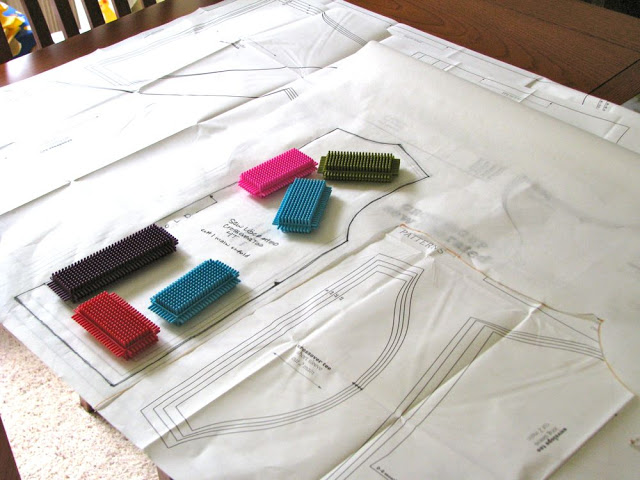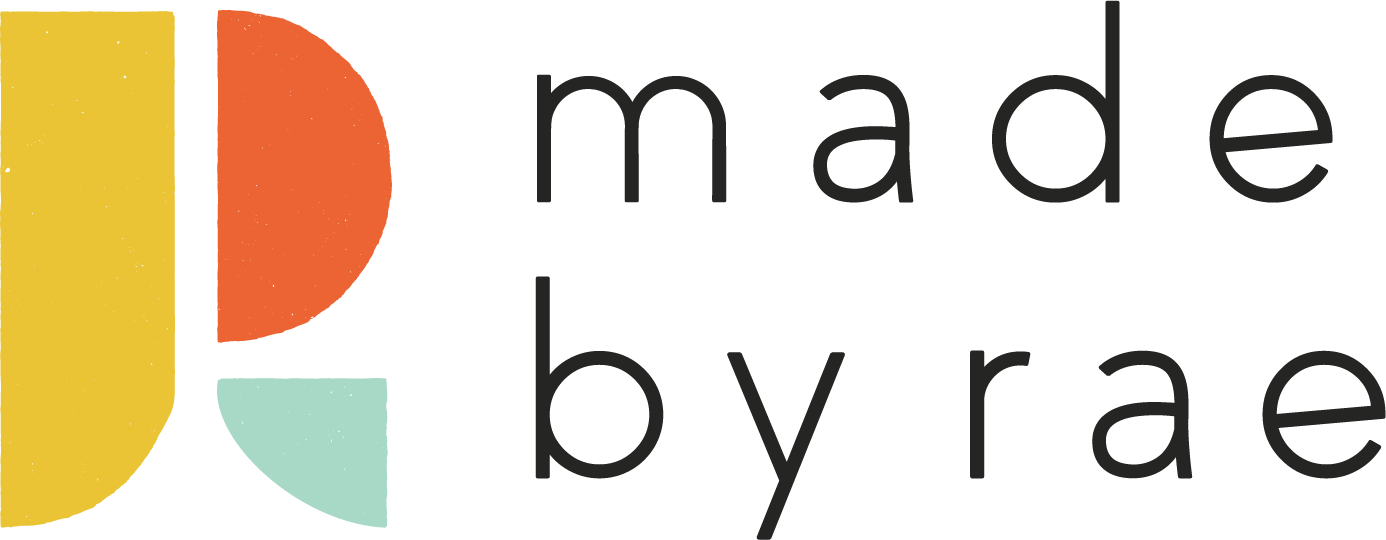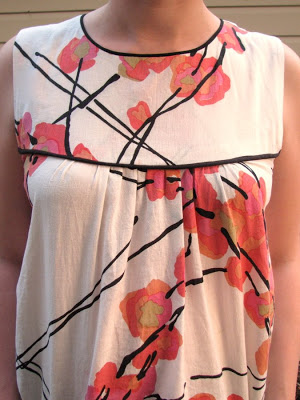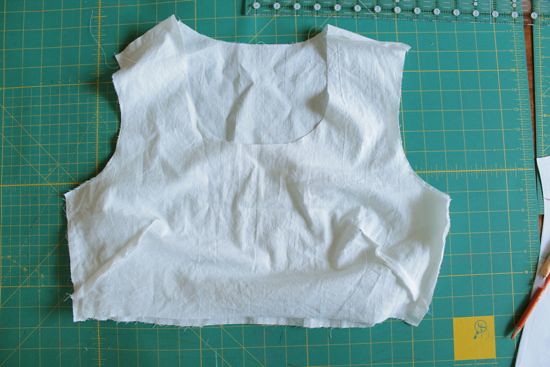Making clothes for me, lessons learned
I have to admit that reading your comments on the Orange Washi Dress post last week made me freak out, just a little bit. For one thing, it made me really excited to see how excited so many of you are for this pattern. NO PRESSURE. (UPDATED: the Washi Dress is now available as a print-at-home pattern in my shop)But the other thing: I worry that some people might think that because I have spent so much time on the pattern, getting the bust darts just the way I want them, for example, that the bust darts will automatically be perfect for you as well. Knowing what I know about women's bodies (that we are curvy and all shaped differently), I know that just simply isn't true. And while the Washi Dress has some really awesome qualities from a fit-standpoint (like shirring in the back so that people who need back darts like me won't need to add them (yay!) and a fair bit of cup-size flexibility), I'm afraid that people will pick up the pattern and be disappointed when it doesn't fit them perfectly right off the bat.So I want to talk a little bit about the things I've learned in the process of making clothes for myself over the years in hopes that some of these pointers will help some of you find ways to get a good fit when you make clothes for yourselves! I started sewing clothing for myself right around junior high, and though I don't remember much about that anymore, I'm pretty sure the first thing I ever sewed for myself garment-wise was a yellow cotton skirt. I DO remember much of the clothing I made back then was pretty baggy and big, so fit wasn't always much of an issue. Yay 90's!Most people my age who started sewing when they were young share the same experience as I did: If you wanted to sew a piece of clothing for yourself, you would go to the fabric store, flip through the McCalls (or Simplicity or Butterick, Vogue was "too hard") catalog, pick out a pattern you liked, find the fabric you liked, and then read the back of the pattern envelope to get your size and yardage. The construction process was pretty standard as well: you'd cut out the pattern pieces in "your size" from those insanely finicky tissue pattern pages, then pin the pieces to your folded fabric with a bajillion teensy pins, carefully cut out your size (right through the tissue) using sewing scissors, sew it together, and hope for the best. I think my mom taught me to do it this way because this was just the way her mom had taught her to do it, and so on. How many generations back did this go? I have no idea.I've been "selfish sewing" pretty seriously for the last 5 years or so now, and I've discovered that this process just doesn't really work for me anymore. For one thing, tissue paper patterns make me crazy. For another, my body is far more curvy and dynamic than it used to be when I was 15 (Having two babies did not help. I gained about 45 pounds when I was pregnant with Clementine and never lost all of it). And with current styles being much more fitted than they were back in the 1990's, I've come to understand that the "hope-for-the-best" philosophy when it comes to picking a size is actually pretty delusional.How to cope? It doesn't make any sense to sew things for myself that are going to fit poorly. I'm just not going to wear them, and what's the fun in that. And why go through the entire process only to discover at the *end* that it doesn't fit? Depressing! Big SAD FACE!!!So, here are some of the lessons I've learned, steps I've built in to my sewing process that have helped insure that when I make something, it's not a surprise at the end how it will fit. And sure, these steps take extra time. But again, is it better just to hope for the best just so I can save a little time? Nope, nope, nope-ity nope.Choosing sizeMy bust, waist, and hip measurements all put me into different sizes on most women's patterns, commercial or independent (waaah). If I pick a dress pattern based on hip measurement, it comes out too big, if I pick based on bust measurement, it's usually too small. So, what to do? Most of the time, I pick based on the most important measurement for that pattern. If it's pants, I pick the size based on the waist because I can always take the hips in. If it's a top or dress, I pick the size based on the bust to start with.
I started sewing clothing for myself right around junior high, and though I don't remember much about that anymore, I'm pretty sure the first thing I ever sewed for myself garment-wise was a yellow cotton skirt. I DO remember much of the clothing I made back then was pretty baggy and big, so fit wasn't always much of an issue. Yay 90's!Most people my age who started sewing when they were young share the same experience as I did: If you wanted to sew a piece of clothing for yourself, you would go to the fabric store, flip through the McCalls (or Simplicity or Butterick, Vogue was "too hard") catalog, pick out a pattern you liked, find the fabric you liked, and then read the back of the pattern envelope to get your size and yardage. The construction process was pretty standard as well: you'd cut out the pattern pieces in "your size" from those insanely finicky tissue pattern pages, then pin the pieces to your folded fabric with a bajillion teensy pins, carefully cut out your size (right through the tissue) using sewing scissors, sew it together, and hope for the best. I think my mom taught me to do it this way because this was just the way her mom had taught her to do it, and so on. How many generations back did this go? I have no idea.I've been "selfish sewing" pretty seriously for the last 5 years or so now, and I've discovered that this process just doesn't really work for me anymore. For one thing, tissue paper patterns make me crazy. For another, my body is far more curvy and dynamic than it used to be when I was 15 (Having two babies did not help. I gained about 45 pounds when I was pregnant with Clementine and never lost all of it). And with current styles being much more fitted than they were back in the 1990's, I've come to understand that the "hope-for-the-best" philosophy when it comes to picking a size is actually pretty delusional.How to cope? It doesn't make any sense to sew things for myself that are going to fit poorly. I'm just not going to wear them, and what's the fun in that. And why go through the entire process only to discover at the *end* that it doesn't fit? Depressing! Big SAD FACE!!!So, here are some of the lessons I've learned, steps I've built in to my sewing process that have helped insure that when I make something, it's not a surprise at the end how it will fit. And sure, these steps take extra time. But again, is it better just to hope for the best just so I can save a little time? Nope, nope, nope-ity nope.Choosing sizeMy bust, waist, and hip measurements all put me into different sizes on most women's patterns, commercial or independent (waaah). If I pick a dress pattern based on hip measurement, it comes out too big, if I pick based on bust measurement, it's usually too small. So, what to do? Most of the time, I pick based on the most important measurement for that pattern. If it's pants, I pick the size based on the waist because I can always take the hips in. If it's a top or dress, I pick the size based on the bust to start with. Tracing pattern piecesI almost never cut into my pattern pieces even when I am absolutely certain that I know the pieces will fit me just the way I want them to. This means that to try out sizes, I trace them using swedish tracing paper first. I know that "takes it up a notch" for some of you home sewists, but it is seriously one of the BEST supplies in my sewing room and I don't know how I ever lived without it.Once I have taped together a PDF pattern, I can just trace the size I want and then fold it all up and put it into a file folder. If I need a different size later, there's no need to print it out again, I just unfold the pattern sheet and trace again (the same is true for pattern pages from sewing project books or even tissue patterns). I've found the swedish tracing paper pieces last longer than paper anyway (they can be pressed, sewed together, and are really hard to tear...they are actually similar to dryer sheets when it comes to tensile strength). I talked about tracing patterns at the end of this post last year (pictured above).Another thing: if I think I am between two sizes or I'm just not sure, I trace TWO sizes while I've got the pattern sheet spread out on my dining room table. That will save me time later!
Tracing pattern piecesI almost never cut into my pattern pieces even when I am absolutely certain that I know the pieces will fit me just the way I want them to. This means that to try out sizes, I trace them using swedish tracing paper first. I know that "takes it up a notch" for some of you home sewists, but it is seriously one of the BEST supplies in my sewing room and I don't know how I ever lived without it.Once I have taped together a PDF pattern, I can just trace the size I want and then fold it all up and put it into a file folder. If I need a different size later, there's no need to print it out again, I just unfold the pattern sheet and trace again (the same is true for pattern pages from sewing project books or even tissue patterns). I've found the swedish tracing paper pieces last longer than paper anyway (they can be pressed, sewed together, and are really hard to tear...they are actually similar to dryer sheets when it comes to tensile strength). I talked about tracing patterns at the end of this post last year (pictured above).Another thing: if I think I am between two sizes or I'm just not sure, I trace TWO sizes while I've got the pattern sheet spread out on my dining room table. That will save me time later!
Making muslinsThis is probably the single most important thing I have learned to do when it comes to making clothes for myself. Once I have my pattern pieces traced, I cut them out of muslin FIRST before I touch my Real Fabric. And by "muslin" I literally mean the super cheap unbleached stuff you can buy by the bolt at JoAnn. Don't wash or dry it either. I used to make "wearable muslins" (see the example shown above, which was a wearable muslin made for this final top) but I've since realized that it's way faster to make a real muslin-muslin. Sometimes I will make just a partial muslin, like the one shown below that I made for the Washi Dress. In this case, I already knew that the skirt would fit, but I was worried about the bodice, so I made the muslin for just the top half of the dress.
When you make a muslin, you machine-baste the seams together instead of sewing them with a regular stitch length (learned that from Liesl Gibson at a Weekend Sewing workshop), and do absolutely NO finishing. No hemming, no facings, no bias binding, etc. If the pattern calls for darts or pleats, you definitely do those (they affect fit!) but skipping all of the more tedious construction steps is a huge timesaver. Then I try it on. If that muslin doesn't fit, I either try the next size down/up, or make changes such as pinching the muslin together in places where it gapes to see if you can take the seam on the side somewhere to make it fit. The whole muslin process (cutting, basting together, trying on, making another muslin) usually takes me a half hour to an hour, max. The trick is to do it really really quick. And it takes time, DEFINITELY. But the time you save in the long run is irreplaceable!Blending sizesUnless you are fortunate enough to have a body that fits perfectly into your muslin the first time, you may have to adjust the pattern a bit at this point. If a muslin is too big on top but too small on the bottom, you can pinch the muslin along the side seams to see where to sew it to make it fit. Sometimes I need to draw a line along the side of the pattern from say, the size 8 line at the bust to the size 12 line at the hip, to "blend" the two sizes together. That is a pretty easy fix. I've also discovered that sometimes I fall right between the size S and M size in some patterns. When that happens, I literally (while I am tracing) draw a line *right* between those two sizes' pattern lines to get new pattern pieces that will fit me better.Bust adjustmentI've known for awhile that both my armpits and my bust apex* (the fullest part of your bust) were lower than average. Armpits always felt too high, even when everything else fit fine, and bust darts always seem to point OVER my bust...not cool! So the armpit thing was pretty easy to fix, I just cut out the armholes a little lower than normal, sometimes up to an inch. It turns out that sliding a bust dart down (or up) is actually pretty easy as well! If a bust dart doesn't point to your bust apex*, it will look weird. Sometimes it's just a matter of sliding it up or down the pattern a bit. See this post on i could make that! for a nice tutorial on moving a bust dart.*This is NOT the same thing as your nipple. OK just realized that in the course of just one week I have used the words "boob" and "nipple" on this blog. Greeeeat.Last week I finally came to terms with the fact that, being small-chested, I might have to occasionally do a small bust adjustment. For women who are more largely-endowed, I have learned that knowing how to do a Full Bust Adjustment (or FBA) on any pattern is a) pretty easy once you learn and b) TOTALLY WORTH IT because oh my goodness things finally fit properly!! A small bust adjustment and a full bust adjustment are pretty similar, in one you spread the pieces together (SBA) and the other you spread the pieces apart (FBA).I just this month started subscribing to Creativebug -- a crafty video website where for the price of your subscription you can watch as many videos as you want -- and one of THE BEST videos on there which I think completely justifies the price of your subscription in one fell swoop is Liesl Gibson's Bust Adjustment video. You can see a preview at that link as well. The way she breaks it down so clearly is a beautiful thing to behold I tell you. If a Creativebug subscription is not in the cards for you, even for one month, here are a couple of tutorials to try (although I have to say, watching it on a video is so much better in my opinion):http://sewmamasew.com/blog2/2008/05/full-bust-alterations-or-adjustments-fba/http://sew-la-fabric.blogspot.com/2010/04/full-bust-adjustment-aka-fba.htmlor just google "Full Bust Adjustment" to find oodles of links that will help you learn how (that's what I did to get those links, y'all. The Power of the Internet). I swear, for those of you who are Big Up Top, once you learn how to do this, you will never go back. A whole new world of sewing will open before you.Read upI can't really take credit for any of this information. All of it is stuff I've learned from other places. Let me recommend a few books that I feel are easy to understand and give great information about fit and sewing for yourself. These are some books I own and consult on a regular basis:
- Built By Wendy books. Especially her "Dresses" book goes into nice detail about adjusting fit, making muslins
- Colette Sewing Handbook: Also some great info on making muslins and adjusting patterns to fit, including bust adjustment. Her blog, Coletterie, also has a ton of great fit tutorials, and although most are specific to her patterns, many include principles that can be adapted to other women's patterns as well
- Design-it-yourself clothes by Cal Patch - this is a great intro to pattern making, and although it's really basic (no bust darts, etc), it was really a life-changer for me in terms of understanding the basic dimensions of a pattern and how to manipulate them. By the way, did you see that Cal's also got pattern-making lessons on Creativebug too? Awesome.
OK. I could keep going but at some point this is going to stop being a blog post and turn into it's own book instead. Hopefully I have given you a few great pointers for ways to perfect your Selfish Sewing.I definitely feel that sewing for oneself is a process learned over time, not a single leap into couture-sewing for most to be sure. But it can be really rewarding to start to see the hard work pay off. I feel like I should know -- five years ago I was sewing straight from a pattern, and now I'm making my OWN patterns! It all happens with baby steps. And If you already do these things (or have other suggestions that you feel strongly about), please suggest!!



